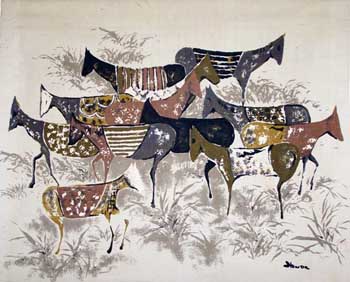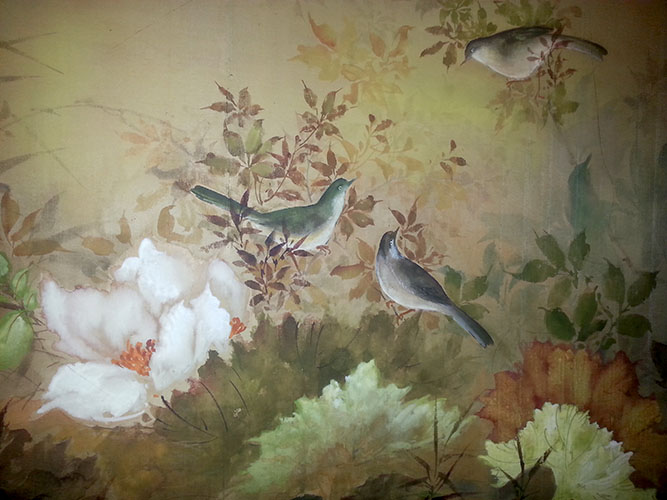Many thanks
to Greg Chase (January 2006) for sending me the pictures and
text for this page.
All photos are Greg's unless otherwise noted. |

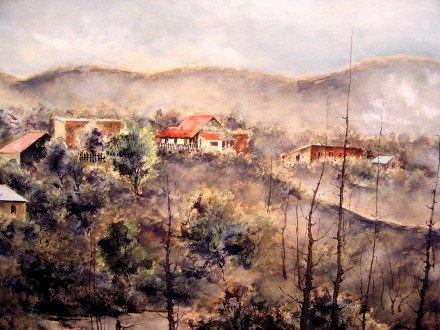
1956 Hiroshi
Honda Painting |

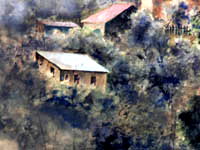
Detail A
|
Hiroshi Honda
Japanese American Hawaiian Artist
Watercolor, 1956
Rarely does his work ever appear.
Hiroshi Honda was an American Citizen that was put in one of
the United States WWII Concentration Camps. This is a fact that
the United States Government really doesn't want any of us to
remember. They don't teach this to us in grammar school. In 1942,
110,000 Japanese Americans living on the West Coast of the United
States were relocated to ten internment camps. It took another
forty years for the US government to recognize the violations
of this population and culture's constitutional rights. Hiroshi
Honda was one
|
of a very few artists who captured
daily life in these camps in his
paintings. Most of his paintings from the Internment Camps hang
in the Smithsonian Museum in Washington DC. Recently, the Honolulu
Academy of the Arts prepared an Exhibit on Honda's paintings.
The Exhibit was called Reflections of Internment: The Art
of Hawaii's Hiroshi Honda. The exhibit showed how these aesthetically
and historically important paintings recorded the despair, isolation,
and boredom of daily camp life. And how his work also serves
to remind us that we must constantly and consistently safeguard
the rights of our citizens in order to assure freedom and equal
justice for all.
|
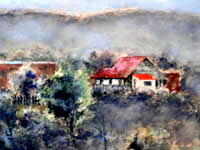
Detail B
|
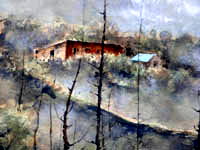
Detail C
|
Ever since I purchased this painting
I have been afraid to list it for sale. I having been buying
and selling art for over 10 years. The values of most artists
paintings are based on past auction results and the art markets
interest in that subject. But, paintings from this artist have
not come up and the historical importance of this painting is
huge. So, I have been scared to sell it because I am afraid that
I am going to undervalue the piece and sell it cheap to only
find out later it was worth a fortune. This is a fabulous painting
depicting life in a Japanese Immigrants Village somewhere in
California in the 1950's. There are three people fishing at a
small pond below a small village.
|
There are seven small homes or shacks. Asian
America Immigrants where not allowed to buy Land in California
because of Legislation called the California Alien Land Law that
was passed in 1913. Asian Immigrants where only allow to lease
land in 3 year terms. So the Japanese Immigrants lived in small
villages such as what it this painting is showing us. It was
not until 1948 in the Legal Case Oyama v. California, the Supreme
Court struck down the Alien Land Laws as violations of the Fourteenth
Amendment. This painting is dated 1956. The paintings in the
Smithsonian by Hiroshi Honda reflect the life of the Japanese
Americans from 1942-1945. This painting
|
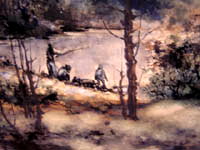
Detail D
|
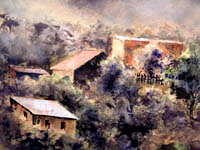
Detail E
|
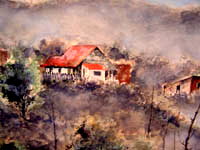
Detail F
|
reflects another day in the life of
that culture shortly after their Internment. This painting should
be in the Smithsonian in that collection to add to that timeline
of earlier paintings. This painting expresses the life of the
Japanese Immigrants more than a decade after their release from
the Interment Camps. White Caucasian Americans had a very good
quality of life after World War II. Jobs were plentiful. They
supplied enough income for almost all to afford to buy a home
and live the American dream. This painting shows the meek life
the Japanese Immigrants were living 11 years after WWII. The
painting gives off a somber feeling. The day looks overcast and
the trees have lost their leaves. The feeling it gives me reaches
out to those people who lived in those shacks. The artist certainly
knew how to express more that just the scenery. You actually
feel something when you know the history of these people and
then look at this painting. The painting talks to you. That is
why I think this is such a historically important painting.
Gregory Chase, January 2006 |

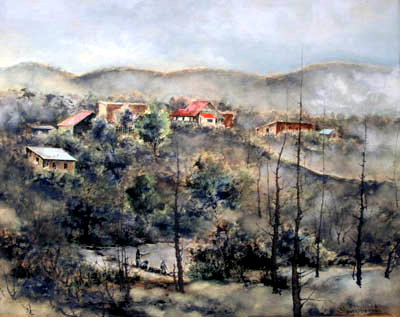
|


Thanks to Susan
Lipman for sharing this Hiroshi Honda tapestry.
|
Hello
Ray,
Thank you for posting the Cave Horses on your website. I don't
know if I ever told you how I came about this piece of art? A
few years ago I was in our local Good Will Store and as I unrolled
this canvas there were the horses. I just fell in love with this
piece and the price was right. The store clerk told me she almost
threw this out in the garbage. I thanked her for not doing that.
I picked it up thinking my daughter, in college at the time,
might like it to hang in her apartment that had a huge bare wall;
but, needless to say, I kept it and she hasn't seen it until
just recently.
Thanks again,
Susan Lipman |
|
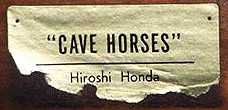
|


Hiroshi Honda
Paintings: Courtesy of a Private Collection
|
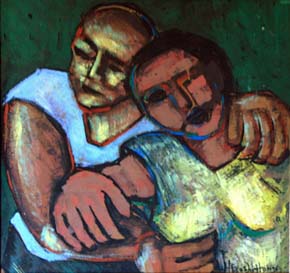
"Man and a Woman"
by Hiroshi
Honda
|
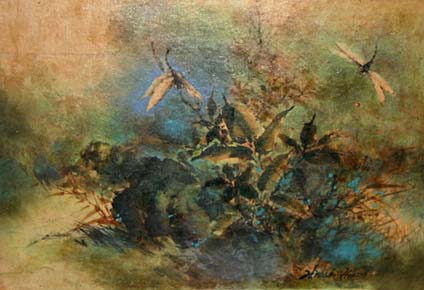
"Dragonflies"
by Hiroshi
Honda
|
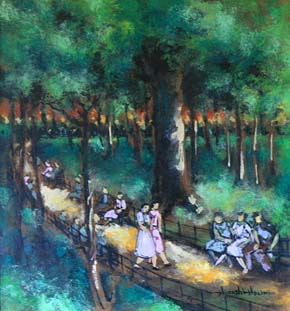
"Central Park"
by Hiroshi
Honda
|
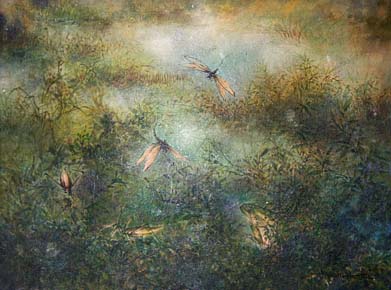
"Dragonflies and
the Frog"
by Hiroshi
Honda
|
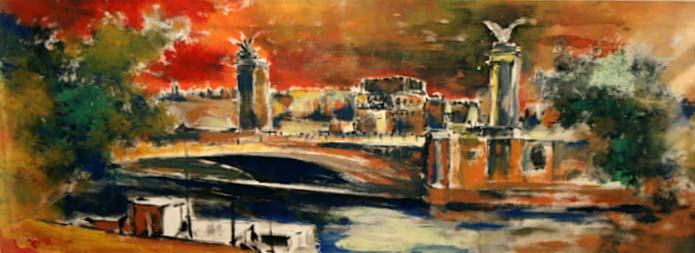
by Hiroshi Honda
|
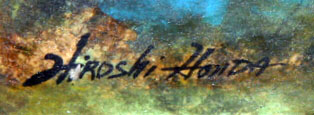
|



Hiroshi Honda
Painting: Courtesy of Robert Gilpin |
Ray,
I appreciate any help you can offer towards getting this piece into a proper 'home' where it can be appreciated by many for years to come.
We acquired this painting around ten years ago from my wife's family (if you look closely, you can see they were smokers - I can only imagine how beautiful it will look after a professional cleaning).
I was familiar with Hiroshi Honda's most famous works; images of the WW2 internment camps, but when I saw this nature scene, I was amazed.
Attached please find pictures of our painting, hopefully someone will love it as much as we now do.
Robert
2015. |
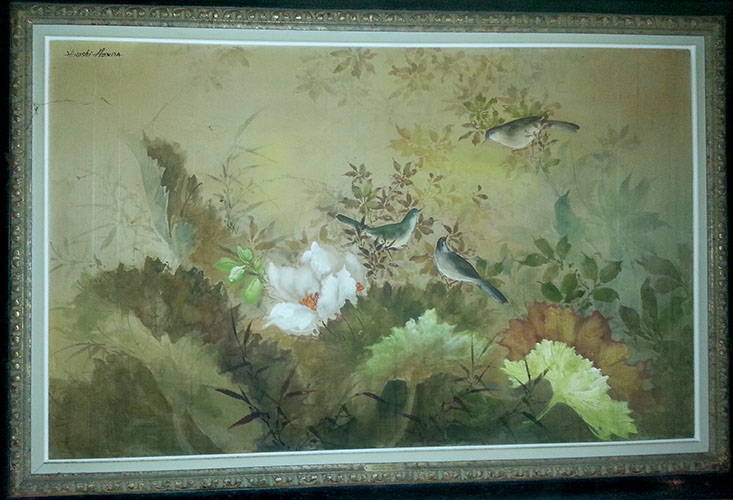 Bokkotsu on Silk by Hiroshi Honda
Bokkotsu on Silk by Hiroshi Honda
|
|


|
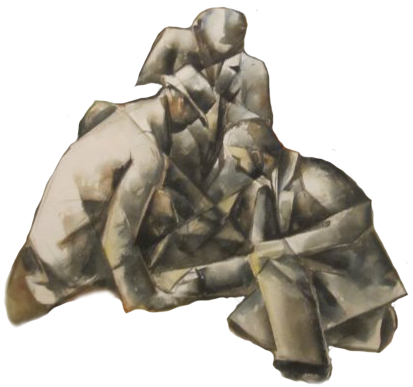














![]()










